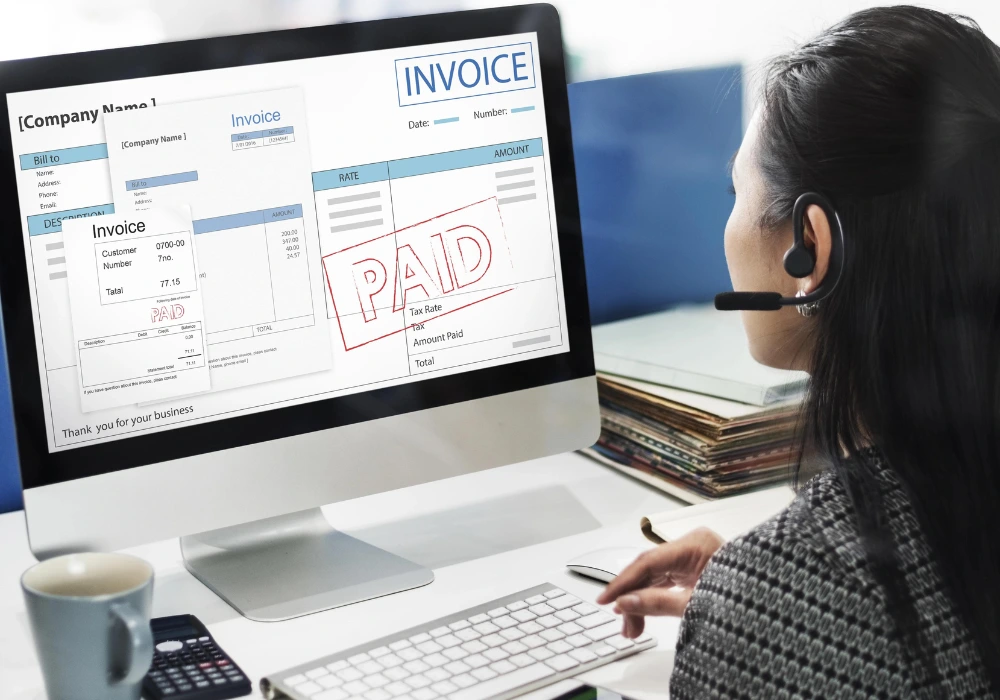Last Updated on November 28, 2025
Introduction
The GST act was implemented in 2016 in India. Since then, it has proven to be a step towards transformative transparency.
With the introduction of GST, the domino effect of taxes is gone. GST makes the tax compliance process simple and streamlined for all vendors. The proper execution of the GST system takes place because of a meticulous procedure that involves many detailed documents. One such document is the GST invoice bill.
What is a GST invoice?
A GST invoice is a document that serves as evidence of a transaction involving the supply of goods or services under the Goods and Services Tax (GST) system. It is generated by a registered taxpayer in compliance with the GST regulations. The invoice contains essential details such as the seller’s and buyer’s information, description of the goods or services, quantity, value, and applicable taxes. The GST invoice ensures transparency, accountability, and proper record-keeping of transactions in the GST regime.
Read More: What is a Tax Invoice: Meaning, Types, Format and Example
What is the GST invoice bill?
The term “GST invoice bill” is commonly used to refer to the GST invoice. It represents the document a registered taxpayer generates as evidence of a supply of goods or services under the Goods and Services Tax (GST) system. The GST invoice bill includes key information such as the seller’s and buyer’s details, description of the goods or services, quantity, value, and applicable taxes. It serves as a legal record of the transaction, providing clarity and transparency in the GST framework.
Importance of GST Invoice Bills
GST invoice bills hold significant importance for businesses and the GST system.
Here is why:
1. Legal compliance
Generating GST invoice bills is a legal requirement for registered taxpayers under the GST regime. It helps businesses comply with tax laws and regulations, avoiding penalties and legal consequences.
2. Input tax credit (ITC) claims
GST invoice bills play a crucial role in claiming input tax credits. Businesses can avail themselves of the ITC facility by ensuring they have valid and accurate GST invoice bills for their purchases. These invoices are evidence of claiming credits against the tax paid on inputs, reducing the overall tax liability.
3. Transparency and accountability
GST invoice bills promote transparency in business transactions. They clearly summarise the goods or services supplied, their value, and the applicable taxes. This transparency helps in preventing tax evasion and fosters accountability among businesses.
Quick Read: Billing: What is it, Types, Process, How it Works & Format
Impact of GST invoice bills on business operations
The GST invoice bill has several impacts on business operations.
1. Efficient tax compliance
By maintaining accurate and proper GST invoice bills, businesses can streamline their tax compliance processes. It helps them easily calculate and report their GST liabilities, ensuring they meet their tax obligations accurately and promptly.
2. Enhanced cash flow management
The timely issuance of GST invoice bills enables businesses to manage their cash flow effectively. They can promptly raise and collect payments with proper invoices, reducing the risk of delayed or disputed payments.
3. Improved business reputation
Maintaining proper GST invoice bills reflects professionalism and integrity in business operations. It enhances the reputation of the business, instils trust among customers and suppliers, and can potentially lead to increased business opportunities.
4. Simplified audits and assessments
Accurate GST invoice bills simplify the process during audits or assessments by tax authorities. It provides a clear trail of transactions and ensures compliance with tax regulations, reducing the chances of scrutiny or disputes during audits.
The benefit of GST invoice bill
The GST invoice bill offers several benefits to businesses and the overall taxation system.
Here are some key advantages.
- Transparency: GST invoice bills promote transparency in business transactions, preventing tax evasion and fostering accountability.
- Efficient record-keeping: These invoices serve as essential records for financial and auditing purposes, facilitating efficient record-keeping.
- Smooth business operations: By maintaining accurate GST invoice bills, businesses can streamline their tax compliance processes, enhance cash flow management, and simplify audits or assessments.
Quick Read: 6 Best Cash Flow Management Software
Types of GST invoice bills
Here are the different types of invoices for GST
- Tax invoice: A standard invoice issued for taxable supplies of goods or services.
- Bill of Supply: An invoice for exempted or non-taxable supplies or businesses registered under the Composition Scheme.
- Revised invoice: An updated invoice issued to correct errors or change a previous invoice.
- Debit and credit notes: These are issued to adjust the value or correct errors in the original invoice.
- Export invoice: An invoice generated for supplies of goods or services to foreign countries.
- E-commerce operator invoice: An invoice issued by an e-commerce platform for transactions facilitated through their platform.

Read More: 7 Types of Invoices for Your Business with Format
Key components of a GST invoice bill
A GST invoice bill contains various essential components that need to be included. These components are-
- Name and address of the supplier
- GSTIN (Goods and Services Tax Identification Number) of the supplier
- Name and address of the recipient
- GSTIN of the recipient (if registered)
- Invoice number and date
- Description of goods or services
- Quantity and unit of measurement
- Payable value of goods or services
- Applicable taxes (CGST, SGST, IGST)
- Total invoice value
- Additional details (if any)
- Place of supply
- Serial number
Quick Read: 12 Best Invoicing Software
GST invoice bill requirements
When creating a GST invoice bill, there are specific requirements to ensure compliance with the GST regulations.
Here are the key requirements:
- General format guidelines: The invoice should be legible, clearly printed, and contain all necessary information in a structured format.
- Mandatory fields and information: Certain details, such as the supplier’s name, address, GSTIN, invoice number, date, description of goods or services, quantity, value, and applicable taxes, must be included.
- Optional fields and additional information: While not mandatory, additional details such as shipping address, payment terms, and terms of delivery can be included for clarity and convenience.
- Electronic invoicing (E-invoicing) and digital signatures: Businesses may choose to generate invoices electronically and use digital signatures to ensure the authenticity and integrity of the invoice.
How to create a GST invoice bill?
Creating a GST invoice bill involves several steps to ensure accuracy and compliance.
Here’s a step-by-step guide:
- Determine the type of GST invoice bill required based on the nature of the supply.
- Gather the necessary information, including the supplier’s and recipient’s details, invoice number, date, description of goods or services, quantity, value, and applicable taxes.
- Include additional optional fields and information if relevant to the transaction.
- Calculate the total invoice value, including the taxes.
- Ensure the invoice follows the prescribed gst invoice format and contains all mandatory fields.
- If using e-invoicing, generate the invoice electronically and consider using digital signatures for authenticity.
- Review the invoice for accuracy and completeness.
- Provide copies of the invoice to the recipient and maintain a record for future reference and auditing purposes.
Quick Read: 6 Best E Invoicing Software
GST invoice bill format
The GST invoice bill format may vary depending on the specific requirements of the business and the industry. However, it generally includes essential information such as the supplier’s details, recipient’s details, invoice number and date, description of goods or services, quantity, value, applicable taxes, and the total invoice value. The format can be customized to match the branding and layout preferences of the business.
An example of a GST invoice bill format is provided below:

Validating and verifying GST invoice bills
Validating and verifying GST invoice bills is crucial to ensure their accuracy and authenticity.
Here are the key aspects to consider:
- Cross-checking details with the GST portal: Businesses should cross-check the details mentioned in the GST invoice bills with the information available on the GST portal. This helps confirm the accuracy of the GSTIN, tax rates, and other relevant information.
- Verification of supplier’s GSTIN and authenticity: It is important to verify the supplier’s GSTIN (Goods and Services Tax Identification Number) mentioned on the invoice. This can be done by validating the GSTIN on the GST portal or using other authorized verification tools. Verifying the authenticity of the supplier ensures that the transaction is genuine.
- Detecting fake or fraudulent transactions: Businesses should be vigilant in detecting fake or fraudulent invoices. This includes checking for signs of manipulation, such as incorrect tax calculations, invalid GSTIN, suspiciously low prices, or unauthorized use of the business’s name or logo. Implementing robust internal controls and staying informed about common invoice scams can help identify and prevent fraudulent invoices.
Quick Read: 5 Simple Ways to Improve Invoice Processing
GST invoice bill and tax compliance
GST invoice bills play a crucial role in ensuring tax compliance for businesses.
Here are the key aspects related to tax compliance:
- Applicable tax rates and calculations: GST invoice bills should accurately mention the applicable tax rates and perform proper calculations to determine the tax amounts. Businesses must stay updated with the current tax rates and apply them correctly to ensure accurate tax reporting and payment.
- Reverse charge mechanism: In certain scenarios, the liability to pay GST shifts from the supplier to the recipient under the reverse charge mechanism. The GST invoice bill should clearly indicate when the reverse charge applies, along with the necessary details for the recipient to fulfil their tax obligations.
- HSN (Harmonized System of Nomenclature) and SAC (Services Accounting Code) codes: GST invoice bills should include the appropriate HSN or SAC codes for the goods or services being supplied. These codes help in standardizing and classifying products and services for accurate tax classification and reporting.
- Matching and reconciling invoices for ITC claims: Businesses must match and reconcile their GST invoice bills with the corresponding supplier invoices to claim Input Tax Credit (ITC). It involves ensuring that the details mentioned in the invoice match the supplier’s records, including the tax amounts and the supplier’s GSTIN. Proper matching and reconciliation procedures help businesses accurately claim ITC, reducing their overall tax liability.
GST invoice bill for different business types
GST invoice bills are applicable to various types of businesses across different industries.
Here are a few examples of businesses that require GST invoice bills:
- Retailers
- Manufacturers
- Service Providers
- E-commerce Operators
- Exporters and Importers
- Contractors
- Freelancers
Quick Read: Difference Between Invoice and Bill: A Complete Guide
Best Practices for Generating GST Invoice Bills
When generating GST invoice bills, following best practices ensures accuracy, compliance, and smooth business operations.
Here are some key practices to consider:
- Use Standardized Templates: Utilize standardized templates or accounting software to generate GST invoice bills. This helps maintain consistency, professionalism, and ensures that all necessary information is included.
- Double-Check Details: Thoroughly review the invoice details before issuing them to ensure accuracy. Check for any errors or omissions in the supplier’s and recipient’s details, invoice numbers, dates, and product or service descriptions.
- Include Mandatory Fields: Ensure that all mandatory fields, such as the supplier’s and recipient’s GSTIN, invoice number, date, description of goods or services, and applicable taxes, are properly included in the invoice.
- Maintain Sequential Invoice Numbers: Assign and maintain sequential invoice numbers to maintain a proper record and prevent any gaps or duplications in the invoice numbering sequence.
- Accurate Tax Calculations: Calculate the applicable taxes accurately, including CGST (Central Goods and Services Tax), SGST (State Goods and Services Tax), and IGST (Integrated Goods and Services Tax), based on the transaction type and the respective tax rates.
- Preserve Invoice Copies: Keep copies of the GST invoice bills for your records and make sure they are easily accessible. This helps during audits, reconciliations, and resolving any disputes or discrepancies.
- Timely Issuance: Issue the GST invoice bills in a timely manner as prescribed by the GST laws. Timely invoicing helps facilitate smooth business transactions, maintains compliance, and ensures accurate tax reporting.
Read More: Invoice Discrepancy: How to Avoid and Resolve Invoice Disputes?
Common mistakes to avoid in GST invoice bills
To prevent errors and ensure compliance, it’s important to be aware of common mistakes that should be avoided when generating GST invoice bills.
Here are some examples:
- Incomplete or Missing Information: Avoid omitting essential details such as the supplier’s and recipient’s information, GSTINs, invoice numbers, dates, and descriptions of goods or services. Incomplete information may lead to non-compliance and complications during audits or reconciliations.
- Incorrect Tax Rates or Calculations: Ensure accurate tax rate application and calculations. Using outdated or incorrect tax rates can result in incorrect tax liability assessment and may lead to penalties or disputes.
- Non-compliance with format requirements: Follow the prescribed format for GST invoice bills, including the placement and structure of the mandatory fields. Non-compliance with the format requirements can result in non-acceptance of the invoice by authorities or difficulties during tax assessments.
- Missing or vnvalid HSN or SAC codes: Include the appropriate Harmonized System of Nomenclature (HSN) codes for goods or Services Accounting Code (SAC) for services. Omitting or using incorrect codes can lead to misclassification and incorrect tax reporting.
Conclusion
In conclusion, the GST invoice bill is a vital document for businesses operating under the Goods and Services Tax system. It serves as evidence of a transaction, facilitates tax compliance, and enables the claiming of Input Tax Credit. By adhering to the prescribed format, including mandatory fields, and practicing best invoicing practices, businesses can ensure accurate and transparent invoicing processes.
The GST invoice bill streamlines business operations, enhances tax compliance, and promotes transparency in financial transactions, ultimately contributing to the growth and efficiency of businesses in the GST regime.
FAQs
E-invoicing under GST refers to the generation and exchange of invoices electronically in a standardized format. It involves the use of the GSTN (Goods and Services Tax Network) for real-time reporting and validation of invoices. E-invoicing aims to streamline the invoicing process, reduce errors, enhance efficiency, and facilitate seamless integration of invoice data with the GST portal.
Any registered supplier who sells goods or provides services is required to issue GST compliant invoices. It is mandatory for businesses registered under the Goods and Services Tax (GST) to issue a GST invoice bill for every taxable supply made to another registered person or entity.
To get a GST invoice bill, you need to make a purchase from a registered supplier. The supplier will issue the GST invoice bill to you, containing all the necessary details of the transaction, including the supplier’s information, the recipient’s information, invoice number, date, description of goods or services, quantity, value, applicable taxes, and the total invoice amount.
The GST bill, also known as the GST invoice, is typically issued by the supplier in either physical or electronic format. If you receive a physical copy, you will have a hard copy of the bill. If the invoice is sent electronically, you can download it from the email, messaging platform, or any other means through which it was shared with you.
The e-way bill is a separate document required for the movement of goods exceeding a certain value, as prescribed by the GST authorities. It is generated electronically and contains details such as the consignor, consignee, goods being transported, and the vehicle used. On the other hand, a GST bill, also known as a tax invoice, is a document that contains the details of a specific transaction, including the goods or services supplied, the amount of tax charged, and other relevant information. While both documents are related to GST compliance, they serve different purposes in the supply chain.
No, if you are not registered under the Goods and Services Tax (GST), you cannot issue a GST invoice bill. The GST invoice bill is specifically meant for registered businesses to document their taxable supplies and facilitate the claiming of Input Tax Credit (ITC).
A tax invoice is issued by a registered supplier for taxable supplies made to another registered person. It contains the details of the transaction, including the tax charged, and enables the recipient to claim Input Tax Credit. On the other hand, a bill of supply is issued when a registered supplier makes exempted or non-taxable supplies, or when the recipient is registered under the GST composition scheme. A bill of supply does not include any tax amount and cannot be used to claim Input Tax Credit.
As per the GST regulations, any modifications or corrections to a GST invoice bill can be made in the subsequent invoices or debit/credit notes. Once an invoice has been issued, it should not be altered or modified. However, if there are any errors or changes required, they can be rectified through the issuance of revised invoices or appropriate debit/credit notes.
If you receive an incorrect GST invoice bill, you should contact the supplier and communicate the discrepancies or errors. Request them to issue a revised invoice or a debit/credit note to rectify the mistake. It is important to ensure that the invoice reflects the correct information for accurate tax reporting and compliance.
Yes, there are specific formats and templates available for a GST invoice bill. The GST laws require certain mandatory fields and information to be included in the invoice. While the format may vary based on business preferences, it is crucial to include all the necessary details as prescribed by the GST authorities.
Yes, you can issue a GST invoice bill for services rendered. Whether you provide goods or services, as long as you are a registered GST taxpayer and the transaction is taxable, you are required to issue a GST invoice bill. The invoice should include the relevant details of the services provided, such as description, quantity, value, and applicable taxes.
To calculate GST on a GST invoice bill, you need to determine the applicable tax rates for the goods or services supplied. Multiply the taxable value of the goods or services by the respective GST rate (CGST, SGST, or IGST) to calculate the tax amount. The total invoice value is the sum of the taxable value and the GST amount.
Yes, you can claim Input Tax Credit (ITC) based on a GST invoice bill, provided you meet the eligibility criteria. To claim ITC, the invoice should be valid, accurate, and in compliance with GST rules. The GST paid on purchases or expenses can be set off against the GST liability on sales or outputs, reducing the overall tax liability.
Yes, non-compliance with GST invoice bill requirements can lead to penalties. Failure to issue a GST invoice bill or issuing an incorrect invoice can result in penalties levied by the tax authorities. It is essential to adhere to the invoicing rules and maintain accurate records to avoid any penalties or legal implications.
Yes, you can issue a GST invoice bill for export transactions. The invoice issued for exports is known as an Export Invoice. It should include specific details related to the export transaction, such as the recipient’s billing address outside India, the applicable Integrated Goods and Services Tax (IGST), and other relevant export-related information.
Yes, electronic invoices, or e-invoices, are accepted as GST invoice bills. The government has introduced the e-invoicing system, which allows the generation, exchange, and validation of invoices electronically. E-invoices generated in the prescribed format and complying with the GST rules are considered valid GST invoice bills.
For goods, the time limit for issuing a GST invoice bill is generally before or at the time of delivery or the date of issue of the invoice, whichever is earlier. For services, the invoice should be issued within 30 days from the date of supply of services. However, there are specific provisions for continuous supply or banking/financial sectors, so it is important to adhere to the relevant time limits.
Yes, it is important to keep a copy of the GST invoice bill for your records. As a registered taxpayer, it is your responsibility to maintain proper books of accounts and retain the invoices issued and received. Keeping copies of the GST invoice bills helps in ensuring accurate tax reporting, facilitating audits, and providing evidence of transactions.
Yes, you can issue a GST invoice bill for advance payments or deposits received from your customers. Such invoices are known as Advance Payment Invoices. They should clearly mention that they are for advance payments and include details of the advance amount, the tax rate applicable, and the GST amount. When the actual supply of goods or services takes place, a regular invoice should be issued, adjusting the advance amount.
To validate the authenticity of a GST invoice bill, you can follow these steps:
1. Cross-check the details mentioned on the invoice with the information available on the GST portal, such as the supplier’s GSTIN, invoice number, and due date.
2. Verify the supplier’s GSTIN by using the GSTIN search function on the GST portal.
3. Check for any signs of tampering or forgery on the invoice, such as alterations or inconsistencies in the information provided.
4. Validate the invoice against supporting documents, such as purchase orders, delivery challans, or contracts, to ensure the accuracy of the transaction details.
5. If you suspect a fake or fraudulent invoice, report it to the relevant tax authorities for further investigation.
By taking these steps, you can ensure the authenticity and validity of the GST tax invoice bill you have received.
Yes, GST (Goods and Services Tax) is a central tax system implemented in various countries, including India.
Registered taxpayers who are suppliers of goods or services issue GST invoices.
A GST return is a periodic statement filed by registered taxpayers to provide information about their sales, purchases, and the amount of GST (Goods and Services Tax) payable or claimable. The return serves as a summary of a taxpayer’s financial activities and serves as a basis for calculating the tax liability or refund.
A GST-registered business refers to a business entity that is registered under the Goods and Services Tax (GST) system implemented in certain countries.
GST affects NBFCs by increasing compliance burden and administrative costs due to the requirement of maintaining proper records, issuing GST-compliant invoices, filing GST returns, and fulfilling other GST-related obligations. It may also impact the cost of services provided by NBFCs, as GST is applicable to certain financial services, potentially leading to increased costs for customers.
HSN stands for Harmonized System of Nomenclature. The HSN code is an internationally recognized system of product classification used to classify goods for taxation and trade purposes. It is a numeric code assigned to each product or commodity to provide a uniform and systematic identification system.
An invoicing software, also known as an invoice software or billing software, is a computer program or application designed to create, manage, and send invoices to customers or clients.
UTGST stands for Union Territory Goods and Services Tax. It is a type of tax levied on the supply of goods and services in Union Territories (UTs) of India.










Discussion about this post